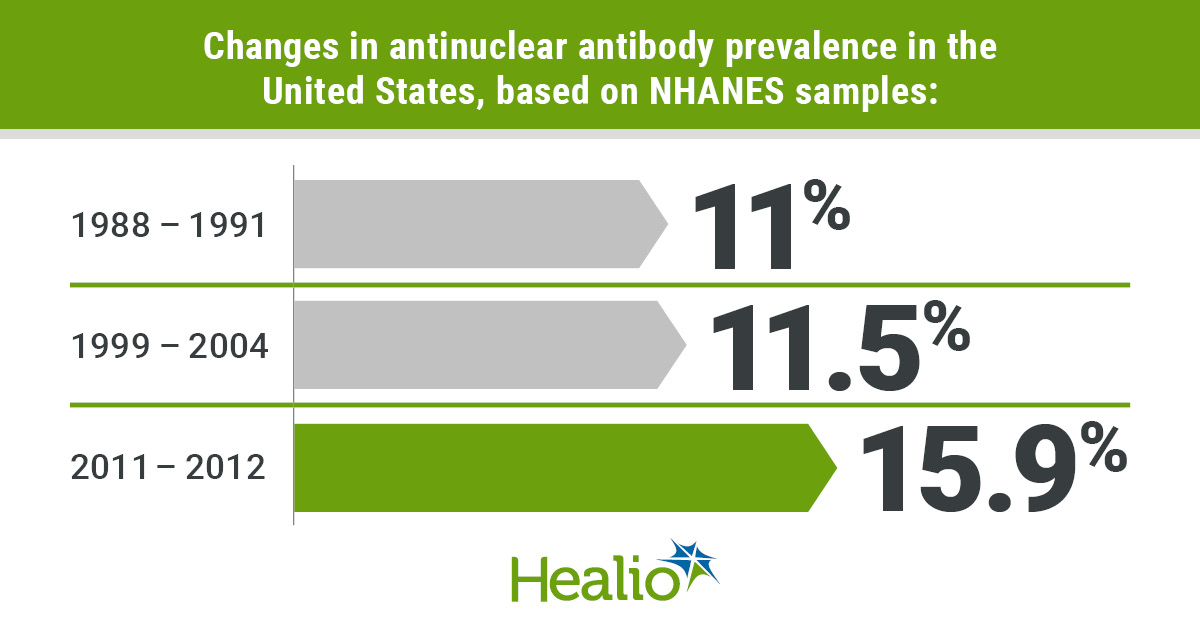‘Worrisome’ rise in autoimmunity reported in U.S.

The prevalence of antinuclear antibodies, markers of the body’s immune responses against its own cells, has increased significantly in the United States over the past several decades, particularly among adolescents and adults aged 50 years and older, according to data published in Arthritis & Rheumatology.
“These findings are worrisome in that they suggest that these increasing immune abnormalities might predict increased numbers of lifelong and costly autoimmune diseases in the United States in the future,” Frederick W. Miller, MD, PhD, of the NIH National Institute of Environmental Health Sciences, told Healio Rheumatology. “While the full implications of these findings are not clear, it is hoped that they will stimulate more research in defining the environmental triggers for ANA and the autoimmune diseases in which they are frequently found.”
To analyze how the prevalence of antinuclear antibodies has changed in the past 25 years, Miller and colleagues measured serum levels in 14,211 individuals aged 12 years and older, measured by standard indirect immunofluorescence assays, sampled from the U.S. National Health and Nutrition Examination Survey (NHANES). The researchers used data from three periods — form 1988-1991, 1999-2004 and 2011-2012.
The researchers considered age, sex and race/ethnicity as correlates of antinuclear antibodies, as well as possible explanatory variables of time trends. They used logistic regression to adjust for these variables to estimate changes in antibody prevalence across all three periods.

According to the researchers, the prevalence of antinuclear antibodies was 11% (95% CI, 9.7% to 12.6%) in 1988‐1991, 11.5% (95% CI, 10.3% to 12.8%) in 1999‐2004, and 15.9% (95% CI, 14.3% to 17.6%) in 2011‐2012 (P < .0001). This corresponds to approximately 22 million, 27 million and 41 million impacted individuals, respectively. Further, prevalence rose steeply among individuals aged 12 to 19 years, with odds ratios of 2.02 (95% CI, 1.16‐3.53) and 2.88 (95% CI, 1.64‐5.04) in the second and third periods, respectively, compared with the first (P < .0001).
Antinuclear antibody prevalence increased in men and women, but especially in men, as well as those aged 50 years or older and non-Hispanic whites. These increases were not explained by concurrent trends in obesity, smoking or drinking, the researchers wrote.
Miller suggested that diet and lifestyle changes overtime could be contributing to why these increased are occurring.
“Immune system responses and immune-mediated diseases result from interactions between our genetic makeup and environmental exposures,” Miller said. “Because our genes have not changed much in the last few decades, one or more of the many recent changes in our lifestyles and environmental exposures must be responsible for the ANA increases. These changes include altered diets, lower physical activity levels, increased life stresses, changes in sleep patterns, different occupations, different pathogens and exposures to new chemicals and drugs.”
“Many of these factors have been suspected of altering immune system regulation that could lead to ANA and later autoimmune disease,” he added. “We are continuing to do research in these areas to define and understand these risk factors.” – by Jason Laday
Disclosures: The researchers report no relevant financial disclosures.
